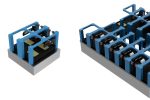APES unveils Matrix6D at RAPID + TCT 2025: Modular, software-defined factory platform for additive electronics
Advanced Printed Electronic Solutions (APES), a U.S.-based developer of next-generation additive manufacturing systems, has officially launched Matrix6D, a modular, reconfigurable additive manufacturing platform designed to overcome one of the industry’s longstanding bottlenecks; scalable production beyond prototyping. The unveiling took place at RAPID + TCT 2025.
Matrix6D departs from the fixed-bed printer paradigm and introduces a “swarm-based” architecture powered by mobile, magnetically levitated build platforms. These units autonomously navigate a configurable grid of multifunctional tool stations, orchestrated by proprietary software, enabling high-throughput and fully customizable additive workflows.
“Every customer we’ve worked with asks the same question: how do we scale 3D printing beyond prototyping? Matrix6D is our answer,” said Rich Neill, CEO of APES. “It’s a clean-sheet reimagining of the additive factory, adaptive, software-defined, and built for mass customization and true production volume.”
APES designs and manufactures adaptive manufacturing systems for the electronics and automation industries. Combining precision robotics, additive manufacturing, and real-time orchestration software, APES enables scalable production workflows from prototyping to volume manufacturing. The company partners with both commercial clients and R&D institutions globally.APES Logo. Image via Advanced Printed Elctronic Solutions.
A new class of AM architecture
At the core of Matrix6D is a grid-configurable tool-cell system, where each station operates as a mini-manufacturing unit. Users can equip these cells with a broad range of deposition technologies, including aerosol jet, inkjet, direct-write, extrusion, and precision dispensing, as well as non-additive processes like UV curing, laser sintering, robotic pick-and-place, or vision-based inspection. This format supports hybrid manufacturing workflows within a single system.
The platform is engineered to support high-mix, low-volume production, enabling manufacturers to fabricate different parts simultaneously with varying process requirements. With machine vision and laser-based self-calibration integrated into each station, Matrix6D can maintain micron-scale precision, even during complex, multi-step processes.
Scalable from lab to factory
Thanks to its parametric design, Matrix6D can be scaled from small 1×2 bench demonstrators to full-scale 5×7 grid arrays and beyond. Each configuration supports interchangeable toolheads, dynamic task allocation, and parallel recipe execution. This allows manufacturers to run multiple jobs concurrently, an advantage for sectors like semiconductors, wearable electronics, aerospace sensors, and high-performance optics.
At RAPID + TCT 2025, APES demonstrated a 1×2 Matrix6D unit featuring live material extrusion, robotic transfer between stages, and magnetic build platform movement. Attendees also previewed a digital twin of a 5×7 configuration, showcasing the platform’s orchestration software and real-time production visualization.
Various configurations of the Matrix6D adaptive 3D printing factory. Image via Advanced Printed Electronic Solutions.
Addressing challenges in the adoption of printed electronics
While additive manufacturing has made significant inroads in metal, polymer, and biofabrication applications, additive electronics remains an underdeveloped frontier. Traditional approaches to electronics manufacturing often struggle with miniaturization, material integration, and design flexibility.
Last year, APES partnered with Integrated Deposition Solutions (IDS) to accelerate the development of 3D printed electronics applications, leveraging IDS’s NanoJet technology. Elsewhere in the field, Optomec has advanced aerosol jet printing for electronic components, upgrading their systems to support higher throughput and complex geometries in printed electronics production.
In Europe, InnovationLab reported a breakthrough in 3D printing multilayer flexible electronics through the SmartEEs2 EU Horizon 2020 project. Similarly, Scrona is bringing ultra-precise AM technology to market for nanoelectronics after raising $9.6 million in funding.
Back in 2020, AM electronics provider Nano Dimension revealed the successful 3D printing and assembly of a double-sided, ten layer PCB, signaling the maturation of AM in semiconductor contexts. In a recent interview at RAPID + TCT 2024, Nano Dimension’s leadership emphasized the industry’s transition toward production-ready electronic additive manufacturing, a vision closely aligned with APES’s modular, software-defined approach.
What 3D printing trends should you watch out for in 2025?
How is the future of 3D printing shaping up?
Subscribe to the 3D Printing Industry newsletter to keep up with the latest 3D printing news.
You can also follow us onLinkedIn and subscribe to the 3D Printing Industry Youtube channel to access more exclusive content.
Featured Image shows configurations of Matrix 6D adaptive 3D factory. Image via APES.


